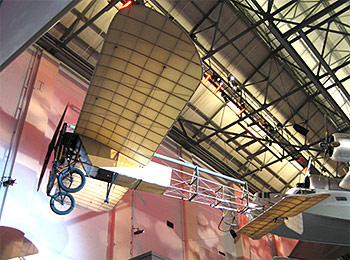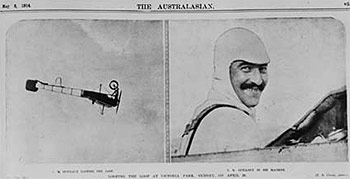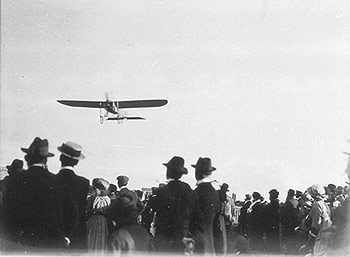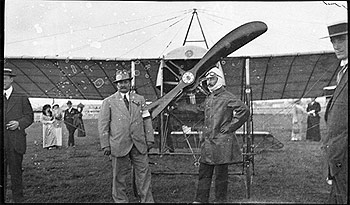Era: 1914 - 1918 Cultural background: French Collection: Powerhouse Museum Theme:Aviation Communication Federation Government Science WW1

The Bleriot XI monoplane flown by Maurice Guillaux. Photograph Stephen Thompson
Collection
Powerhouse Museum, Sydney, Australia.
Object Name
Bleriot XI monoplane.
Object Description
Aircraft, full size, Bleriot XI monoplane, wood / canvas / wire, designed by Louis Bleriot, made by Bleriot Aeronautique, Levallois, Paris, France, 1914, flown by Maurice Guillaux with first Australian airmail from Melbourne to Sydney in 1914. Dimensions: Wing area: 33 m2, propeller diameter: 2.22 m, 11000 mm wide, Weight 300 kg.
This Bleriot XI is one of the earliest civil aircraft to be flown in Australia. Piloted by French stunt pilot, Maurice Guillaux, it pioneered commercial aviation in Australia in 1914, flying the first airmail from Melbourne to Sydney.
This Bleriot XI is one of the earliest civil aircraft to be flown in Australia. Piloted by French stunt pilot, Maurice Guillaux, it pioneered commercial aviation in Australia in 1914, flying the first airmail from Melbourne to Sydney.

The Bleriot XI monoplane flown by Maurice Guillaux. Photograph Stephen Thompson
This Bleriot XI is very similar to the Bleriot XI aircraft which made the first epic flight across the English Channel on the 25th July 1909. It was flown by its French designer, Louis Bleriot, who had spent the previous four years developing a practical aeroplane and learning to fly it. After his successful flight Bleriot capitalised on his fame to become the world’s most successful aircraft manufacturer. His firm, Bleriot Aeronautique, went on to build about 800 type XI monoplanes between July 1909 and August 1914 at a factory near Paris. It was the most significant and influential and the longest-lived aircraft design of the era. Bleriots dominated the air-racing and exhibition circuit in the years prior to World War I. Virtually all major speed, distance and altitude prizes at flying meets around the world from 1909 to 1911 were won by Bleriot pilots. Type XI aircraft formed the embryonic air forces of the French, British, Italian, Austrian and Russian governments while flying clubs as far away as Saigon and Sebastopol used Bleriot aircraft. It was the forebear of a series of ever-more-sophisticated racing and military aircraft produced by firms such as Morane-Saulnier, Blackburn, Fokker and Deperdussin.

The Australasian, 8th May 1914. Courtesy State Library New South Wales
This Bleriot XI monoplane is thought to be a special stunt machine known as a ‘Looper’ which was especially designed for aerial acrobatics. It was built at the Bleriot factory early in 1914. It was purchased by a professional stunt pilot, Maurice Guillaux, who had won numerous flying competitions and races but a fraudulent entry during an air race saw him barred from European competitions at the end of 1913. Guillaux decided upon a promotion aerobatic tour of Australia with the Bleriot XI monoplane, which inadvertently launched Australia’s early interest in aviation. Accompanying him was his manager, Le Maistre, and mechanics M. Cominos, du Coque, and Rupeausseu.
The group arrived in Sydney on the 8th of April 1914 on board the Orontes with the Bleriot packed in a large wooden crate in the hold. On the 20th of April 1914 Guillaux became the first man to ‘loop the loop’ in Australia at a demonstration attended by 60,000 people at Victoria Park Racecourse in Sydney, and four days later was given an official welcome by the Lord Mayor of Sydney. The next day he flew to Newcastle where more aerobatic demonstrations were held. The French party sent the plane by train on to Melbourne in June with more stunt displays landing in the grounds of Government House. Guilluax’s manager also arranged for him to deliver Australia’s first unofficial airmail letter from the Mayor of Melbourne to the Mayor of Geelong. Above Geelong racecourse he gave demonstrations of upside down flying, banking feats and took six passengers on joy flights.
The crash of the plane of a rival American flyer, Eugene ‘Wizard’ Stone, which was smashed to pieces on the 1st of June, gave Guillaux the chance to make the historic first flight between Melbourne and Sydney. Stone and his American promoters had been contracted by the PMG Department (Australia Post) to make the flight and no replacement aircraft was available. The sponsors, Wilson of OT Ltd, a soft drink manufacturer and Arthur Rickard, a real estate developer, approached Guillaux’s manager to undertake the flight and on Thursday, 16th of July 1914, Guillaux left Melbourne with the first 88 kg (40 lb) bag of Australian “aerial mail”. This comprised 1785 souvenir postcards produced by the British Imperial Oil Company (Shell Australia), who also supplied the fuel for the flight, and official letters between the State governors and French consuls. Also a quantity of Lipton’s tea and some OT chilli cordial and lemon squash, consigned to the Commercial Travellers’ Association (Tennis) Club of Sydney, became the first air cargo carried between the two cities. The underside of the Bleriot’s wings featured the wording “ADD a little O.T.”
Guillaux left the Melbourne Agricultural Showground at Flemington at 9.12 am for the 930 km flight. Because the Bleriot’s limited fuel capacity meant it could only be in the air for about 2 hours, the flight was arranged in stages with seven refuelling stops. Suitable towns were selected where a racecourse or a field could be used to land to refuel and they were to be lit by large bonfires visible from the air. Since Guillaux did not know his way to Sydney it was decided he should follow the existing railway line.

Maurice Guillaux flying over a crowd in NSW in 1914. Courtesy State Library New South Wales
The first stop was Seymour, Victoria, where after 42 minutes of flying time Guillaux landed in Jordan’s field. Wangaratta, Victoira, was the next stop where Guillaux landed in J. Sisley’s field, near Racecourse Road. He arrived at the Albury Racecourse at 12.50pm and after lunch with the French Mayor, Georges Frere, he continued on towards Wagga Wagga. There Guillaux caused a sensation by landing at the wrong racecourse, touching down near the judge’s box just as a race had ended. After finding the right racecourse Guillaux made great progress, travelling at a record 120 mph, on his way to Harden. Strong winds and driving rain began buffeting the aircraft only minutes after leaving Harden. The fabric wings stretched to breaking point and the toiling engine coughed and spluttered as Guillaux strove to keep the plane’s nose to the wind. He was finally forced back to Harden feeling sick, wet and cold. Flying conditions on the second day were just as appalling and he had to spend a second night at Harden. It was at 7.45 am on 18 July before Guillaux finally left Harden for Goulburn, again in bad weather, finding his way from the smoke of steam trains on the main line. Ahead of schedule Guillaux set down near a small town in the bush southwest of Sydney. A local, Mr Cloke, told Guillaux it was Liverpool and invited him to stay for lunch, which he did.

Maurice Guillaux at Moore Park in 1914. Courtesy State Library New South Wales
A strong tail wind brought him in to the landing spot at Moore Park in Sydney, still ahead of schedule. Too early for the official reception with the Governor-General, Sir Ronald Munro-Ferguson, Guillaux filled in time by flying between Parramatta and Manly before making his final descent in a storm at Moore Park at 2.50 pm. He was carried shoulder high through cheering crowds. The postal authorities were not very impressed with the flight however, as it had taken longer than the normal train journey, although flying time was only just over 9 hours 35 minutes. Nevertheless, it was the longest airmail flight made in the world at that time.
Guillaux continued to give aerial demonstrations until the Bleriot was badly damaged at Ascot Racecourse near Mascot on the 3rd of August 1914 and he spent six weeks in hospital as a result. After war began in Europe, Guillaux returned to France but not before his last aerobatic display at Bathurst, NSW, on the 12th of September 1914. Guillaux was killed testing an aircraft for the French Air force in 1917.
The Bleriot remained in Australia and was purchased on the 24th of January 1916 by a garage proprietor and taxi operator, Robert Carey of Ballarat, Victoria. Carey had the Bleriot transported to Ballarat where an English pilot friend, Edwin Prosser, was initially his pilot and mechanic. In February 1916 Carey then established the Ballarat Flying School with Prosser as Chief Instructor and himself as Manager. Carey gained his pilot’s certificate, No.34, from the Australian Aero Club and on the 23rd of November 1916 became the first civilian to gain a pilot’s licence from the Commonwealth Flying School, later Central Flying School, Point Cook, Victoria, in the Bleriot. He was rejected as a military aviator because of his age of 42 years.
Carey spent much of the second half of 1917 flying the Bleriot at charitable galas and fetes in connection with the Red Cross “in aid of the soldiers”. Before each flight over any town Carey had to write to the Intelligence Section of the Department of Defence to seek their formal permission. In October 1917 he was asked to give exhibition flights in Adelaide in connection with the CTA Carnival given to aid the Army Nurses’ Appeal, and sent the Bleriot there by rail. Several displays and exhibition flights were undertaken in Adelaide during October and November 1917 during which time Carey continued to help the War effort by dropping official recruiting mail and “loan” leaflets. The GPO then gave permission for the first airmail to be flown in South Australia by Carey on the 23rd of November 1917 between Adelaide and Gawler.
By October 1917 Carey had gained permission to use the Bleriot in conjunction with his “School of Aviation” at Bacchus Marsh racecourse in Victoria. However, by the end of 1917 it appears Carey was no longer using the Bleriot due to the lack of spare parts and it was stored in his car garage at Ballarat.
In 1920 the Bleriot was purchased by one of Carey’s former flying pupils at Port Melbourne, K.J. Claffey, who is said to have installed a bicycle seat behind the pilot’s seat for his paying passengers having joy flights. In 1939 the Bleriot was purchased from Claffey by the Department of Civil Aviation for a proposed display at Mascot. The display did not eventuate and the Bleriot was stored in a shed adjacent to the aerodrome until its location was brought to the attention of the Museum of Applied Arts ands Sciences in 1941 when it was acquired and stored in a Museum store for safe keeping. The Bleriot was partly restored by Mr M.A. Leech, head teacher, Aircraft Construction Class, Sydney Technical College, Ultimo, and his senior Air Force trainees, prior to display at the 21st Anniversary of the Royal Aero Club of New South Wales, at Bankstown Airport on 11 October 1947. The Club again displayed it on the 26th of November 1949. In 1964 the aircraft was given another facelift by the students and displayed at Mascot Airport at an exhibition to commemorate the Jubilee of Guillaux’s historic flight on the 16th of July 1964. Between 1980 and 1981 the aircraft was fully restored by the Museum and temporarily displayed in Stage I of the Powerhouse Museum. Several years later the Bleriot went on permanent display in the Transport Exhibition of the Powerhouse Museum which opened in 1988.
The Bleriot has historic significance as evidence the continuing influx of ideas and technology with migrants and travellers in a pre mass media age. Feats such as that of Guillaux revolutionised the notion of air travel between major cities and led the way for the eventual introduction of the inter city mail services in the 1920s.
The Bleriot has aesthetic significance in the design and manufacture of early aircraft. The Bleriot influenced the design of aircraft across the globe well into the 1920s.
The Bleriot has intangible significance as a reminder of the experience of Australia at the turn of the 20th Century and exposure of the Australians to rapidly changing technology and expertise from Europe and the United States of America. Objects such as the Bleriot have an intangible value to older Australians.
The Bleriot is well provenanced to Guillaux and the various owners since. The Bleriot was acquired by the Museum of Applied Arts & Sciences in 1941. It is now restored and hangs in the Transport exhibition of the Powerhouse Museum
The Bleriot represents a time when Australia saw itself as a predominantly British culture, but was constantly being reminded of a multicultural paradox. Throughout Australian history non – British migrants have played major roles in the technological development of industry, communications and transport and the arts.
The interpretive potential of the aircraft is considerable. The Bleriot interprets the themes of evolution of ideas, skill and technology in Australia and the role of migrants in bringing new technologies and skills. The Bleriot interprets the themes of distances the once separated the States and the bridging of these distances through new technologies such as rail, air travel and telegraphic communication. These breakthroughs were usually introduced by migrants.
Bibliography
Heritage Office & Dept of Urban Affairs & Planning 1996, Regional Histories of NSW, Sydney.
Heritage Collections Council 2001, Significance: A guide to assessing the significance of cultural heritage objects and collections, Canberra.
Websites
index.php?irn=288461&search=guillaux&images=&c=&s=
Migration Heritage Centre
November 2007 – updated 2011
Crown copyright 2007©
The Migration Heritage Centre at the Powerhouse Museum is a NSW Government initiative supported by the Community Relations Commission.
www.migrationheritage.nsw.gov.au
Regional Services at the Powerhouse Museum is supported by Movable Heritage, NSW funding from the NSW Ministry for the Arts.



